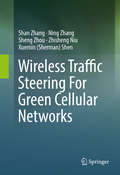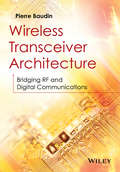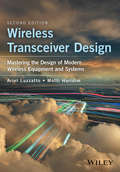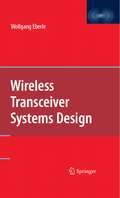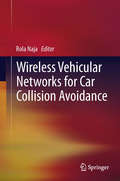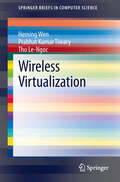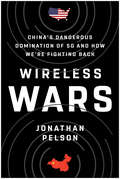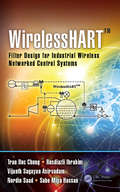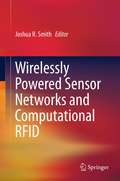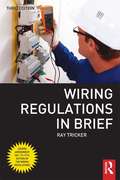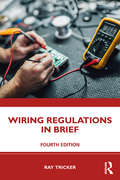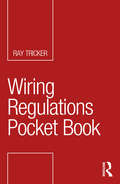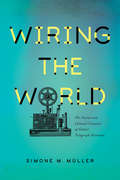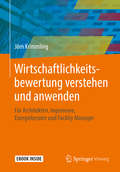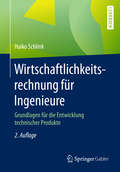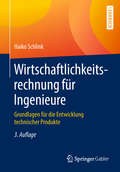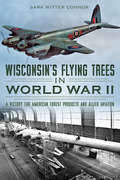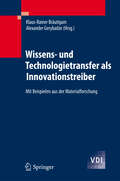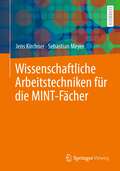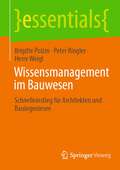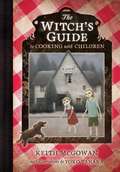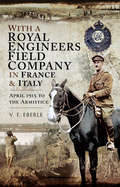- Table View
- List View
Wireless Traffic Steering For Green Cellular Networks
by Shan Zhang Ning Zhang Sheng Zhou Zhisheng Niu Xuemin Sherman ShenThis book introduces wireless traffic steering as a paradigm to realize green communication in multi-tier heterogeneous cellular networks. By matching network resources and dynamic mobile traffic demand, traffic steering helps to reduce on-grid power consumption with on-demand services provided. This book reviews existing solutions from the perspectives of energy consumption reduction and renewable energy harvesting. Specifically, it explains how traffic steering can improve energy efficiency through intelligent traffic-resource matching. Several promising traffic steering approaches for dynamic network planning and renewable energy demand-supply balancing are discussed. This book presents an energy-aware traffic steering method for networks with energy harvesting, which optimizes the traffic allocated to each cell based on the renewable energy status. Renewable energy demand-supply balancing is a key factor in energy dynamics, aimed at enhancing renewable energy sustainability to reduce on-grid energy consumption. Dynamic network planning adjusts cell density with traffic variations to provide on-demand service, which reduces network power consumption with quality of service provisioning during off-peak hours. With intra- or inter-tier traffic steering, cell density is dynamically optimized with regards to the instant traffic load for conventional homogeneous and multi-tier heterogeneous cellular networks, respectively. This book is beneficial for researchers and graduate students interested in traffic management and future wireless networking.
Wireless Transceiver Architecture: Bridging RF and Digital Communications
by Pierre BaudinA fully comprehensive reference combining digital communications and RFIC (Radio Frequency Integrated Circuits) in one complete volume There are many books which focus on the physical implementation of the RF/analog part of transceivers, such as the CMOS design, or the signal processing involved in digital communications. However, there islittle material dedicated to transceiver architecture and system design. Similarly, much of the existing literature looks at concepts useful for dimensioning, yet offers little practical information on how to proceed for dimensioning a line-up from scratch, and on the reasons for proceeding that way. This book redresses the balance by explaining the architecture of transceivers and their dimensioning from the perspective of a RFIC architect from within industry. It bridges the gap between digital communication systems and radiofrequency integrated circuit design, covering wireless transceiver architecture and system design from both system level and circuit designer aspects. • Covers digital communication theory, electromagnetism theory and wireless networks organization, from theories to implementation, for deriving the minimum set of constraints to be fulfilled by transceivers • Details the limitations in the physical implementation of transceivers to be considered for their dimensioning, in terms of noise, nonlinearity, and RF impairments • Presents transceiver architecture and system design in terms of transceivers budgets, transceivers architectures, and algorithms for transceivers
Wireless Transceiver Design: Mastering the Design of Modern Wireless Equipment and Systems
by Motti Haridim Ariel LuzzattoBuilding upon the success of the first edition (2007), Wireless Transceiver Design 2nd Edition is an accessible textbook that explains the concepts of wireless transceiver design in detail. The architectures and the detailed design of both traditional and advanced all-digital wireless transceivers are discussed in a thorough and systematic manner, while carefully watching out for clarity and simplicity. Many practical examples and solved problems at the end of each chapter allow students to thoroughly understand the mechanisms involved, to build confidence, and enable them to readily make correct and practical use of the applicable results and formulas. From the instructors' perspective, the book will enable the reader to build courses at different levels of depth, starting from the basic understanding, whilst allowing them to focus on particular elements of study. In addition to numerous fully-solved exercises, the authors include actual exemplary examination papers for instructors to use as a reference format for student evaluation. The new edition has been adapted with instructors/lecturers, graduate/undergraduate students and RF engineers in mind. Non-RF engineers looking to acquire a basic understanding of the main related RF subjects will also find the book invaluable.
Wireless Transceiver Systems Design
by Wolfgang EberleThe fields of communication, signal processing, and embedded systems and circuits are brought together in this book. These fields come together with a single design goal, a WLAN transceiver which combines analog and digital design, VLSI and systems design, algorithms and architectures, as well as design and CAD/EDA. This book focuses on the overall approach to design problems and design organization needed for transceiver design. It does not focus on one particular standard.
Wireless Vehicular Networks for Car Collision Avoidance
by Rola NajaWireless Vehicular Networks for Car Collision Avoidance focuses on the development of the ITS (Intelligent Transportation Systems) in order to minimize vehicular accidents. The book presents and analyses a range of concrete accident scenarios while examining the causes of vehicular collision and proposing countermeasures based on wireless vehicular networks.The book also describes the vehicular network standards and quality of service mechanisms focusing on improving critical dissemination of safety information. With recommendations on techniques and protocols to consider when improving road safety policies in order to minimize crashes and collision risks.
Wireless Virtualization
by Heming Wen Prabhat Kumar Tiwary Tho Le-NgocThis SpringerBriefs is an overview of the emerging field of wireless access and mobile network virtualization. It provides a clear and relevant picture of the current virtualization trends in wireless technologies by summarizing and comparing different architectures, techniques and technologies applicable to a future virtualized wireless network infrastructure. The readers are exposed to a short walkthrough of the future Internet initiative and network virtualization technologies in order to understand the potential role of wireless virtualization in the broader context of next-generation ubiquitous networks. Three main wireless virtualization perspectives are explored, along with the potential challenges and requirements of a sustainable wireless virtualization framework. Finally, it presents an example of a multi-perspective wireless virtualization framework. The readers learn the latest concepts in the application of wireless virtualization as well as its relationship with cutting-edge wireless technologies such as software-defined radio (SDR) and cognitive radio.
Wireless Wars
by Jonathan PelsonAs the world rolls out transformational 5G services, it has become increasingly clear that China may be able to disrupt—or even access—the wireless networks that carry our medical, financial, and even military communications. This insider story from a telecommunications veteran uncovers how we got into this mess—and how to change the outcome. In Wireless Wars: China's Dangerous Domination of 5G and How We're Fighting Back, author Jon Pelson explains how America invented cellular technology, taught China how to make the gear, and then handed them the market. Pelson shares never-before-told stories from the executives and scientists who built the industry and describes how China undercut and destroyed competing equipment makers, freeing themselves to export their nation&’s network gear—and their surveillance state. He also reveals China&’s successful program to purchase the support of the world&’s leading political, business, and military figures in their effort to control rival nations&’ networks. What&’s more, Pelson draws on his lifelong experience in the telecommunications industry and remarkable access to the sector&’s leaders to reveal how innovative companies can take on the Chinese threat and work with counterintelligence and cybersecurity experts to prevent China from closing the trap. He offers unparalleled insights into how 5G impacts businesses, national security and you. Finally, Wireless Wars proposes how America can use its own unique superpower to retake the lead from China. This book is about more than just 5G wireless services, which enable self-driving cars, advanced telemedicine, and transformational industrial capabilities. It&’s about the dangers of placing our most sensitive information into the hands of foreign companies who answer to the Chinese Communist Party. And it&’s about the technology giant that China is using to project its power around the world; Huawei, a global super-company that has surged from a local vendor to a $120 billion-a-year behemoth in just a few years. For anyone curious about the hottest issue at the intersection of technology and geopolitics, Wireless Wars offers an immersive crash course and an unforgettable read.
WirelessHART™: Filter Design for Industrial Wireless Networked Control Systems
by Tran Duc Chung Rosdiazli Ibrahim Vijanth Sagayan Asirvadam Nordin Saad Sabo Miya HassanThis book presents a guideline for EWMA filter design for industrial wireless networked control system, both theoretically and practically. The filter’s key advantages are simple, effective, low computational overhead. This book also provides a guideline for practical implementation of EWMA filter for improving networked control performance of various process plants. It further discusses not only the advantages of the filter, but also the limitations and how to avoid them when implementing the filter from practical point of view.
Wirelessly Powered Sensor Networks and Computational RFID
by Joshua R. SmithThe Wireless Identification and Sensing Platform (WISP) is the first of a new class of RF-powered sensing and computing systems. Rather than being powered by batteries, these sensor systems are powered by radio waves that are either deliberately broadcast or ambient. Enabled by ongoing exponential improvements in the energy efficiency of microelectronics, RF-powered sensing and computing is rapidly moving along a trajectory from impossible (in the recent past), to feasible (today), toward practical and commonplace (in the near future). This book is a collection of key papers on RF-powered sensing and computing systems including the WISP. Several of the papers grew out of the WISP Challenge, a program in which Intel Corporation donated WISPs to academic applicants who proposed compelling WISP-based projects. The book also includes papers presented at the first WISP Summit, a workshop held in Berkeley, CA in association with the ACM Sensys conference, as well as other relevant papers. The book provides a window into the fascinating new world of wirelessly powered sensing and computing.
Wiring Regulations in Brief: A Complete Guide To The Requirements Of The 16th Edition Of The Iee Wiring Regulations, Bs 7671 And Part P Of The Building Regulations
by Ray TrickerTired of trawling through the Wiring Regs? Perplexed by Part P? Confused by cables, conductors and circuits? Then look no further! This handy guide provides an on-the-job reference source for Electricians, Designers, Service Engineers, Inspectors, Builders, Students, DIY enthusiastsTopic-based chapters link areas of working practice – such as cables, installations, testing and inspection, special locations – with the specifics of the Regulations themselves. This allows quick and easy identification of the official requirements relating to the situation in front of you.The requirements of the regulations, and of related standards, are presented in an informal, easy-to-read style that strips away confusion. Packed with useful hints and tips, and highlighting the most important or mandatory requirements, this book is a concise reference on all aspects of the seventeenth edition IEE Wiring Regulations.
Wiring Regulations in Brief: A Complete Guide To The Requirements Of The 16th Edition Of The Iee Wiring Regulations, Bs 7671 And Part P Of The Building Regulations
by Ray TrickerThis newly updated edition of Wiring Regulations in Brief provides a user-friendly guide to the newest amendments to BS 7671 and the IET Wiring Regulations. Topic-based chapters link areas of working practice – such as earthing, cables, installations, testing and inspection, and special locations – with the specifics of the Regulations themselves. This allows quick and easy identification of the official requirements relating to the situation in front of you. The requirements of the regulations, and of related standards, are presented in an informal, easy-to-read style to remove confusion. Packed with useful hints and tips, and highlighting the most important or mandatory requirements, this book is a concise reference on all aspects of the eighteenth edition of the IET Wiring Regulations. This handy guide provides an on-the-job reference source for electricians, designers, service engineers, inspectors, builders, and students.
Wiring Regulations Pocket Book (Routledge Pocket Books)
by Ray TrickerThis new Routledge Pocket Book provides a user-friendly guide to the latest amendments to the 18th Edition of IET Wiring Regulations (BS 7671:2018). This Pocket Book contains topic-based chapters that link areas of working practice with the specifics of the Regulations themselves. The requirements of the Regulations are presented in an informal, easy-to-read style that strips away confusion. Packed with useful hints and tips that highlight the most important or mandatory requirements, the book is a concise reference on all aspects of the 18th edition of the IET Wiring Regulations. This handy guide provides an on-the-job reference source for Electricians, Designers, Service Engineers, Inspectors, Builders and Students.
Wiring the World: The Social and Cultural Creation of Global Telegraph Networks (Columbia Studies in International and Global History)
by Simone MüllerThe successful laying of a transatlantic cable in 1866 remade world communications. A message could travel across the ocean in minutes, shrinking the space between continents, cultures, and nations. An eclectic group of engineers, entrepreneurs, politicians, and media visionaries then developed this technology into a telecommunications system that spread a particular vision of civilization—but not everyone wanted to wire the world the same way. Wiring the World is a cultural and social history that explores how the large Anglo-American cable companies won out over alternative visions. Bitter rivalries emerged over telegram prices, visions for world peace, scientific innovation, and the role of the nation-state. Such struggles determined the growth of cable technology, which in turn influenced world history. Filled with fascinating characters and new insights into pivotal events, Wiring the World traces globalization's diverse paths and close ties to business and politics.
Wirtschaftlichkeitsbewertung verstehen und anwenden: Für Architekten, Ingenieure, Energieberater und Facility Manager
by Jörn KrimmlingDieses Fachbuch vermittelt Akteuren der Baubranche praxisnah, wie sie ihrem Auftraggeber erläutern welche im jeweiligen Projekt die wirtschaftlichste Variante ist und wie sie dies auch fundiert begründen.Dabei wird sowohl das Prinzip der Wirtschaftlichkeitsbewertung erläutert, als auch auf die verschiedenen Berechnungs-Verfahren eingegangen.
Wirtschaftlichkeitsrechnung für Ingenieure
by Haiko SchlinkDieses Lehrbuch macht Studierende und Lehrende aller Ingenieurdisziplinen mit den für sie relevanten betriebswirtschaftlichen Grundlagen und Methoden vertraut. Da die Entwicklung neuer Produkte meist langwierig und mit hohem Geldeinsatz verbunden ist, wird es immer wichtiger, dass sich Ingenieure systematisch mit der Entscheidungsfindung auseinandersetzen. Andernfalls besteht die Gefahr, dass wichtige Dinge „aus dem Bauch heraus“ entschieden werden und wesentliche Vorstellungen des Unternehmens unberücksichtigt bleiben. Studierende, Lehrende und interessierte Praktiker erfahren, wie sie die Wirtschaftlichkeit von Produktentwicklungen oder -änderungen entwicklungsmethodisch nachhaltig verbessern.Neben anschaulichen Beispielen sind zur Einübung des Stoffes jedem Abschnitt Fragen zur Wiederholung und Vertiefung sowie Übungsaufgaben mit Lösungen zugeordnet.Die 2. Auflage wurde gründlich überarbeitet und insbesondere das erste Kapitel thematisch erweitert und ergänzt.Das Buch enthält ein Geleitwort von em. Univ.-Prof. Dr. oec. habil. Herfried M. Schneider.
Wirtschaftlichkeitsrechnung für Ingenieure: Grundlagen für die Entwicklung technischer Produkte
by Haiko SchlinkDieses Lehrbuch macht Studierende und Lehrende aller Ingenieurdisziplinen mit den für sie relevanten betriebswirtschaftlichen Grundlagen und Methoden vertraut. Da die Entwicklung neuer Produkte meist langwierig und mit hohem Geldeinsatz verbunden ist, wird es immer wichtiger, dass sich Ingenieure systematisch mit der Entscheidungsfindung auseinandersetzen. Andernfalls besteht die Gefahr, dass wichtige Dinge „aus dem Bauch heraus“ entschieden werden und wesentliche Vorstellungen des Unternehmens unberücksichtigt bleiben. Studierende, Lehrende und interessierte Praktiker erfahren, wie sie die Wirtschaftlichkeit von Produktentwicklungen oder -änderungen entwicklungsmethodisch nachhaltig verbessern.Neben anschaulichen Beispielen sind zur Einübung des Stoffes jedem Abschnitt Fragen zur Wiederholung und Vertiefung sowie Übungsaufgaben mit Lösungen zugeordnet. Für die 3. Auflage wurden insbesondere die Bereiche Kostenkalkulation, Produktentwicklung als Investition und betriebswirtschaftliche Entscheidungslehre gründlich überarbeitet und thematisch erweitert.Das Buch enthält ein Geleitwort von Univ.-Prof. em. Dr. habil. Herfried M. Schneider.
Wisconsin Motorists' Handbook
by Wisconsons Department of TransportationThe Wisconsin Motorists Handbook gives you information on driving rules and practices to help you become a safe driver of a car or light truck.
Wisconsin's Flying Trees in World War II: A Victory for American Forest Products and Allied Aviation
by Sara Witter ConnorA look at how the Wisconsin lumber industry and the U.S. Forest Products Laboratory contributed to Allied efforts in World War II.Wisconsin’s trees heard “Timber” during World War II, as the forest products industry of the Badger State played a key role in the Allied aerial campaign. It was Wisconsin that provided the material for the De Havilland Mosquito, known as the “Timber Terror,” while the CG-4A battle-ready gliders, cloaked in stealthy silence, carried the 82nd and 101st Airborne into fierce fighting throughout Europe and the Pacific. Author Sara Witter Connor follows a forgotten thread of the American war effort, celebrating the factory workers, lumberjacks, pilots, and innovative thinkers of the U.S. Forest Products Laboratory who helped win a world war with paper, wood, and glue.
Wissens- und Technologietransfer als Innovationstreiber
by Alexander Gerybadze Klaus-Rainer BräutigamWissens- und Technologietransfer kann beides bewirken: Innovationen antreiben oder hemmen. Am Beispiel der Materialforschung analysieren die Autoren, welche Bedingungen erfüllt sein müssen, damit der Transfer von Wissen- und Technologie aus öffentlich geförderten Forschungseinrichtungen in die Industrie gelingt. Grundlage sind empirische Erhebungen, Recherchen und die Evaluation von Transfervorhaben. Die Empfehlungen richten sich an Forscher, Forschungseinrichtungen und Partner aus der Industrie, die an neuen Produkten und Technologien arbeiten.
Wissenschaftlich schreiben leicht gemacht: Ein Leitfaden für Architektur- und Designstudiengänge
by Martina SwobodaWissenschaftliches Schreiben findet in kreativen Studiengängen wie der Architektur oder im Design anders statt. Hier steht der kreative Prozess im Mittelpunkt, dessen Endprodukt ein Entwurf ist. Oft wird das wissenschaftliche Schreiben dadurch vernachlässigt. Die Folge ist eine geringere Qualität in den schriftlichen Ausarbeitungen.Viele Studenten wissen nicht, wie sie beginnen sollen zu schreiben, wie der Aufbau einer wissenschaftlichen Arbeit aussieht, wie sie motiviert dabeibleiben und was sie tun können, wenn sie eine Blockade haben.Diese Publikation widmet sich den Anforderungen der kreativen Studiengänge, die ihre Ideen zuerst in ihren Entwurf übersetzen und ihn dann verschriftlichen müssen. Der Leser bekommt Hilfestellung beim Vorrgehen und erhält Tipps und Tricks um motiviert, eine hohe Qualität in seiner wissenschaftlichen Arbeit zu erreichen.
Wissenschaftliche Arbeitstechniken für die MINT-Fächer
by Jens Kirchner Sebastian MeyerDas Buch vermittelt die grundlegenden Arbeitstechniken, die für Seminare und Abschlussarbeiten wie auch für die Erstellung wissenschaftlicher Publikationen im Bereich Mathematik, Informatik, der Ingenieur- und Naturwissenschaften (MINT-Fächer) nötig sind. Es deckt den gesamten Ablauf eines solchen wissenschaftlichen Projekts ab: angefangen von der Themendefinition und Projektplanung über die Grundlagen des wissenschaftlichen Arbeitens und Recherchierens bis zur Organisation und Aufbereitung von Informationen, strukturiertem Schreiben sowie Erstellen und Halten von Präsentationen.
Wissensmanagement im Bauwesen: Schnelleinstieg für Architekten und Bauingenieure (essentials)
by Brigitte Polzin Peter Ringler Herre WeiglDie Autoren übertragen theoretische Grundlagen des Wissensmanagements anhand von Praxisbeispielen auf das Bauwesen. Grundlegende Begriffe, das TOM-Modell, die Konzepte von Probst, Raub und Romhardt werden vermittelt. Aktiv betriebene Wissenskultur ist Basis eines erfolgreich umgesetzten Wissensmanagements, das als Führungsaufgabe im Bauwesen kooperatives, wissensorientiertes Führen voraussetzt. Die Lean-Philosophie wird mit einer werte- und zielorientierten und der Situativen Führung verbunden. Die hier vorgestellten Methoden und Tools eines bauaffinen Wissensmanagements zeigen und sichern vorhandenes und fördern die Generierung neuen Wissens im Unternehmen. Ein Implementierungskonzept zeigt, wie Wissensmanagement die Entwicklung von Unternehmenskultur, -organisation und Technik beeinflusst.
The Witch's Guide to Cooking with Children
by Keith Mcgowan Yoko TanakaEleven-year-old inventor Sol must recover his self-confidence if he and his eight-year-old sister, Connie, are to escape the clutches of Hansel and Gretel's witch, to whom they have been led by their new stepmother and the man they believe is their father.
With a Royal Engineers Field Company in France & Italy: April 1915 to the Armistice
by V.F. EberleA memoir of the First World War from the rare perspective of an engineer.VF Eberle MC joined up upon the outbreak of the war in No 2 Field Company Royal Engineers, 48th (South Midland) Division, the same company as his brother, who was a captain. He was commissioned before sailing for France at the end of March 1915 and remained with it for the rest of the war. In that time he saw action on the Somme and in the Advance to the Hindenburg Line before his Division took part for most of the Battle of Third Ypres (Passchendaele). Transferred to Italy at the end of 1917, he took part in the final stages of the war, including the Battle of Asiago. Besides his eloquent description of the work of a field company RE, he spends some time in outlining his role in the development of the Bangalore Torpedo.Based on his wartime letters, diaries, and records—which can now be consulted in the Imperial War Museum—this book gives a detailed picture of the employment of a field company in war, during both periods of both relative tranquility and major offensives. There are relatively few memoirs of Royal Engineers’ officers, especially of those in his position, so close to the line. The memoirs benefit from his key eye for observation and his skillful use of the material available to him, making this a fine addition to the literature of the Great War.
With a Royal Engineers Field Company in France & Italy: April 1915 to the Armistice
by V.F. EberleA memoir of the First World War from the rare perspective of an engineer.VF Eberle MC joined up upon the outbreak of the war in No 2 Field Company Royal Engineers, 48th (South Midland) Division, the same company as his brother, who was a captain. He was commissioned before sailing for France at the end of March 1915 and remained with it for the rest of the war. In that time he saw action on the Somme and in the Advance to the Hindenburg Line before his Division took part for most of the Battle of Third Ypres (Passchendaele). Transferred to Italy at the end of 1917, he took part in the final stages of the war, including the Battle of Asiago. Besides his eloquent description of the work of a field company RE, he spends some time in outlining his role in the development of the Bangalore Torpedo.Based on his wartime letters, diaries, and records—which can now be consulted in the Imperial War Museum—this book gives a detailed picture of the employment of a field company in war, during both periods of both relative tranquility and major offensives. There are relatively few memoirs of Royal Engineers’ officers, especially of those in his position, so close to the line. The memoirs benefit from his key eye for observation and his skillful use of the material available to him, making this a fine addition to the literature of the Great War.
